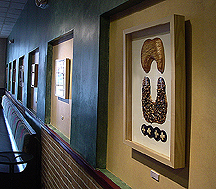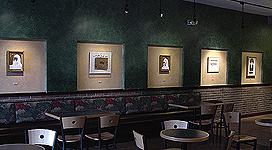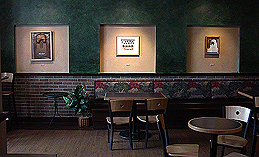
Upanishad Series Statement
" Upanishadem!"
". . . drinking unsteadily through the Kerry quadrilles and Listowel lancers and mastering always with that consecutive fifth of theirs, eh? Like four wise elephants inandouting under a twelvepodestalled table? "
Finnegans Wake - James Joyce
Begun in late 1998 my first exposure to the Upanishads was an allusion in James Joyce's Finnegans Wake. Upon discovering the Hindu Upanishads as philosophical allegories I was struck with the acute visual imagery to the narratives. In particular the Ramayana Upanishad depicting the earth being supported by four elephants. . .
The Ramayana Upanishad
In accord with the
command of their royal Sire, the princes renewed their tunneling and came
upon the monstrous form of the elephant of the quarter, Virupaksha, who
was supporting the earth with it's mountains and forests on his head.
O Kakutstha, at a given moment, when that great elephant shakes his weary
head, an earthquake results therefrom.
The sons of King Sagara, having circumambulated that immense elephant,
protector of the quarter, by digging deeper came to Rasatala.
Having explored the eastern region, they went to the south, and in the
southern quarter, they beheld another great elephant, the magnanimous
Mahapadma, like untoa mountain, who held the earth on his head; and their
astonishment was great.
Having circumambulated him, the sixty thousand sons of Sagara, of great
soul, dug the western quarter; and in the region of the West, a great
elephant, whose bulk exceeded the height of a mountain, named Saumanasa,
appeared to them. Having paid homage to him and questioned him as to his
welfare, they dug until they reached the region that contains the Soma.
In the North, O Illustrious Son of Raghu, they beheld Himpandura of noble
stature, who supported that quarter, and, having cicumambulated him, the
sixty thousand princes hollowed out the earth with fury
The Great Poet
- Valmiki
5th Century B.C.
I had been working on a series of paintings that were/are self-contained compositions and had been thinking about creating a body of work that was thematic in scope. The elephant/earth Upanishad was fecund with thematic approaches.
I began to establish a series images and materials that represented those allegorical elements in symbolic equations. The elephant became quite stylized and its method of representation is also quite varied. Often the elephant is the dominant image and the earth images are contained within. Earth elements are represented through the use of color and materials such as stone, copper, pre-Christian, Neolithic notions, and through the use of the cruciform, scientific symbol as well as religious ikons in multiple faiths. Often the earth is represented in four sequences to indicate time or as map projections as in the homolosine use. Human aspects to the pieces are sometimes revealed through photographic shards or through the use of material such as bone, hair or wax - as used in the Egyptian method of Coptic reliquaries. The use of color also has its significance in thematic use. Blue or the combination of blue and/or white is symbolic of earth, the blue planet, or as water itself. Mirror fragments are also used to indicate sky/earth origins as well their natural quality of access to another dimension.
Robert S. Mirek - March 12, 2001
Click here to view Upanishad Series
Click here to view an installation of 7 Upanishad pieces


